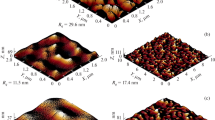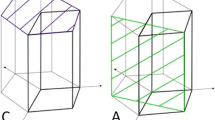Abstract
The peculiarities of the surface processing of polycrystalline aluminum-nitride films on glass-ceramic and silicon substrates grown under identical conditions are considered. Aluminum-nitride films are obtained using the magnetron sputtering of a pure aluminum target (99.99%) in nitrogen–argon plasma at a magnetron power of 700 W. The consumption of working gases is 10 sccm for nitrogen and 4 sccm for argon. The film thickness is determined using a quartz resonator inside the chamber of the magnetron setup. Atomic force microscopy is used to study the surface relief of the targets before and after treatment by argon cluster ions. Small single crystallites are shown to grow on the initial surfaces, the lateral size of which is in the range of 250–550 nm. The depth of target etching by argon cluster ions is determined. Cluster ions with low energy per atom are shown to have a high efficiency of surface smoothing. A comparison of the surface morphology and surface-roughness parameters of aluminum nitride on different substrates obtained using atomic force microscopy is carried out. It is shown that aluminum nitride on silicon is smoothed more efficiently than on a glass-ceramic substrate.
Similar content being viewed by others
Avoid common mistakes on your manuscript.
INTRODUCTION
Aluminum nitride has a unique set of physical and chemical properties, such as high mechanical strength, large piezoelectric coefficients, corrosion resistance, a high breakdown voltage, and high thermal conductivity. Due to this set of properties, films based on aluminum nitride are widely used in insulators, resonators, piezoelectric elements, microelectromechanical systems, and other applications [1–4].
Treatment with cluster ions is an effective method for etching and smoothing the target surface to a subnanometer level of roughness; however, the depth of damage of the processed material is a few nanometers [5–9]. Smoothing occurs due to the collective interaction of cluster atoms with target atoms, which leads to the sputtering and displacement of target atoms mainly along its surface. In contrast to a monomer ion beam, the size (mass) of clusters can be controlled; due to this, it is possible to form an cluster ion beam with very low energy per atom in the cluster (units of eV), which is comparable to the binding energy of particles on the surface of the material [10, 11].
EXPERIMENTAL
Samples of polycrystalline AlN films were obtained using the magnetron sputtering of a target made of pure Al (99.99%) in nitrogen–argon plasma (with a high purity of gases). The film thickness was 1.1 μm; it was determined from the data on the frequency shift of the oscillations of a calibrated quartz resonator inside the chamber under control by atomic force microscopy (AFM) and transmission electron microscopy. Films were formed on substrates made of glass-ceramics ST-50-1-1-0.6 (C-Component, Russian Federation) and single-crystal silicon Si(100) KDB-10 (Russian Federation) at a constant substrate temperature of 350°C. The surface of the substrates was cleaned with an alcohol–acetone mixture followed by washing with de-ionized water before deposition of the AlN film. The magnetron power was 700 W, and the background pressure in the vacuum chamber was 0.07 Pa. The consumption of N2 and Ar working gases was 10 and 4 sccm, respectively.
The processing of AlN films was carried out on the domestic experimental setup CLIUS briefly described in [12] with normal incidence of clusters on the target surface. Earlier [11, 13] it was shown that at a low specific cluster energy E/Nmean (several eV/atom), the target surface is sputtered more slowly, but is smoothed better. Based on these results, a low-energy processing mode was chosen with the following parameters of argon clusters: the average cluster size was Nmean = 1000 atoms and the kinetic energy of clusters was E = 10 keV. The average current density of cluster ions ⟨j⟩ on the target was 0.5 μA/cm2. The average etching rate of the target surface ⟨v⟩ was determined from the ratio of the average etching depth to the treatment time, and it was about 0.25 nm/min. To determine the etching depth, masking of a part of the sample surface was used. On the left and right boundaries of the treated area (which were formed due to masking) two measurement areas with dimensions of 100 × 100 μm were selected. Three boundary profiles were plotted for each area and the height difference at the boundary, i.e., the etching depth, was determined. Table 1 shows the parameters of the surface treatment of polycrystalline AlN films.
An NTEGRA Prima HD atomic force microscope (NT-MDT, Russian Federation) was used to analyze the surface morphology of the samples. Topography measurements were carried out using ETALON HA_C probes (NT-MDT, Russian Federation) with a force constant of 0.26 N/m ± 20%, a resonant frequency of 19 kHz ± 10%, and a tip radius of less than 10 nm. The measurements were carried out in the contact mode with a spatial resolution of 1024 × 1024 pixels at different sizes of the scanning area (2 × 2 and 10 × 10 µm) with a scanning frequency of 1 Hz.
RESULTS AND DISCUSSION
Figures 1 and 2 show AFM images of the initial surfaces of the polycrystalline AlN film and the surfaces of the AlN film on different substrates after treatment with cluster ions. The initial AFM images show a submicron structure. Earlier in [14, 15] it was described that, during magnetron sputtering, single-crystal formations originate on small equiaxed grains located on the surface. With increasing film thickness, the surface acquires a hilly microstructure with a crystallite axis perpendicular to the target surface. In the case under consideration, the lateral size (diameter) of single-crystal formations is in the range of 250–550 nm. It should be noted that the crystallites grown on silicon are smoother, as can be seen from Figs. 1a and 2a. As a result of treatment with cluster ions with a low energy of the atom in the cluster (E/Nmean = 10 eV/atom), the maximum height of irregularities Rt on the surface of the AlN film on glass-ceramics decreased to 30 nm and up to 12 nm for the AlN film on silicon, which is almost 12 times less than the initial value of Rt on a scale of 2 × 2 µm.
It should be noted that the effective smoothing of surface irregularities was achieved at a small etching depth (30–40 nm) of material. Table 2 shows the root mean square (RMS) roughness of the surface ⟨Rq⟩ for different sizes of the scanning area. As can be seen from Table 2, after treatment with argon cluster ions, ⟨Rq⟩ decreases especially effectively, down to 1.5–3 nm, for the AlN film on Si.
CONCLUSIONS
The results of an experimental study of the processing of polycrystalline AlN films by an unseparated argon cluster ion beam were presented. The effective smoothing of AlN crystallites with a diameter of hundreds of nanometers was demonstrated at small etching depths (30–40 nm) of material. The results of smoothing of AlN films grown on different substrates (glass-ceramics and silicon) were compared. Aluminum nitride grown on a Si substrate is smoothed by a factor of 4.5–13 (depending on the size of the scanning area), while an AlN film grown on glass-ceramics is smoothed by a factor of 3–6.3. It should be taken into account that the roughness of the initial AlN film on glass-ceramics is 1.5–2.5 times higher than the roughness of the initial AlN film grown on Si.
REFERENCES
Y. Q. Fu, J. K. Luo, N. T. Nguyen, et al., Prog. Mater. Sci. 89, 31 (2017). https://doi.org/10.1016/j.pmatsci.2017.04.006
J. Kischkat, S. Peters, B. Gruska, et al., Appl. Opt. 51, 6789 (2012). https://doi.org/10.1364/AO.51.006789
V. S. Kudyakova, R. A. Shishkin, A. A. Elagin, et al., J. Eur. Ceram. Soc. 37, 1143 (2017). https://doi.org/10.1016/j.jeurceramsoc.2016.11
N. A. Bert, A. D. Bondarev, V. V. Zolotarev, et al., Semiconductors 49, 1383 (2015). https://doi.org/10.1134/S1063782615100036
N. Toyoda and I. Yamada, AIP Conf. Proc. 866, 210 (2006). https://doi.org/10.1063/1.2401497
T. Wu, D. R. Swenson, and Z. Insepov, Phys. Rev. Spec. Top. 13, 093504 (2010). https://doi.org/10.1103/PhysRevSTAB.13.093504
N. Toyoda, S. Houzumi, and I. Yamada, Nucl. Instrum. Methods Phys. Res., Sect. B 242, 466 (2006). https://doi.org/10.1016/j.nimb.2005.08.129
A. Kirkpatrick, S. Kirkpatrick, M. Walsh, et al., Nucl. Instrum. Methods Phys. Res., Sect. B 307, 281 (2013). http://doi.org./10.1016/j.nimb.2012.11.084
A. E. Ieshkin, D. S. Kireev, Yu. Ermakov, et al., Nucl. Instrum. Methods Phys. Res., Sect. B 421, 27 (2013). https://doi.org/10.1016/j.nimb.2018.02.019
I. Yamada, J. Matsuo, N. Toyoda, and A. Kirkpatrick, J. Eur. Ceram. Soc. 37, 1143 (2017). https://doi.org/10.1016/S0927-796X(01)00034-1
N. G. Korobeishchikov, I. V. Nikolaev, and M. A. Roenko, Tech. Phys. Lett. 45, 274 (2019). https://doi.org/10.1134/S1063785019030295
N. G. Korobeishchikov, I. V. Nikolaev, and M. A. Roenko, Nucl. Instrum. Methods Phys. Res., Sect. B 438, 1 (2019). https://doi.org/10.1016/j.nimb.2018.10.019
N. G. Korobeishchikov, I. V. Nikolaev, M. A. Roenko, and V. V. Atuchin, Appl. Phys. A 124, 833 (2018). https://doi.org/10.1007/s00339-018-2256-3
B.-H. Hwang, C.-S. Chen, H.-Y. Lu, and T.-C. Hsu, Mater. Sci. Eng., A 325, 380 (2002). https://doi.org/10.1016/S0921-5093(01)01477-0
C. Duquenne, M.-P. Besland, P. Y. Tessier, et al., J. Phys. D: Appl. Phys. 45, 015301 (2011). https://doi.org/10.1088/0022-3727/45/1/015301
Funding
The study was carried out using equipment of the Center for Collective Use “Applied Physics,” Novosibirsk State University with financial support of the Russian Science Foundation (grant no. 21-19-00046) in terms of processing the samples with cluster ions and analysis, and the Ministry of Education and Science of the Russian Federation (grant FSUS-2020-0029) in terms of sample preparation and analysis.
Author information
Authors and Affiliations
Corresponding authors
Ethics declarations
We declare that we have no conflict of interest.
Additional information
Translated by S. Rostovtseva
Rights and permissions
About this article
Cite this article
Nikolaev, I.V., Korobeishchikov, N.G., Geydt, P.V. et al. Peculiarities of the Processing of Polycrystalline AlN Films on Glass-Ceramic and Si Substrates by Argon Cluster Ions. J. Surf. Investig. 16, 480–483 (2022). https://doi.org/10.1134/S1027451022040152
Received:
Revised:
Accepted:
Published:
Issue Date:
DOI: https://doi.org/10.1134/S1027451022040152






